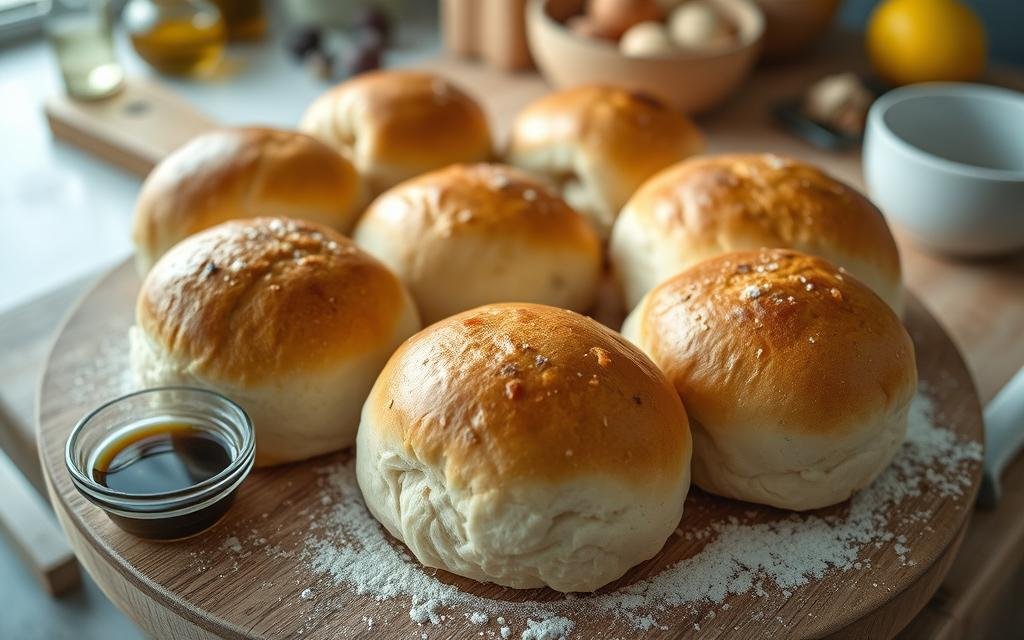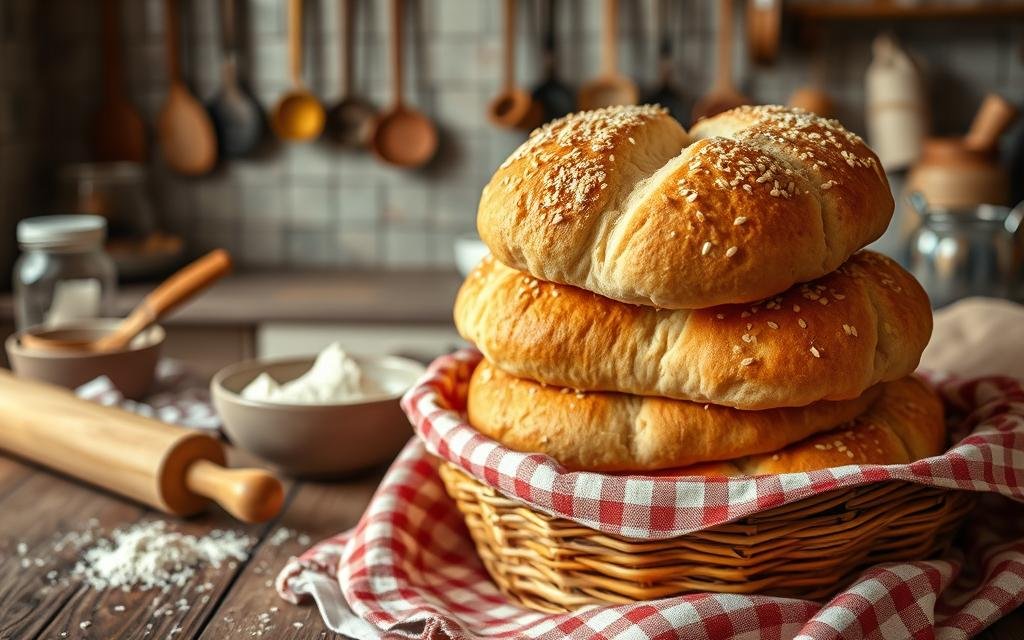The smell of fresh bread in your kitchen takes you straight to Italy. Biting into a crusty Italian roll, you feel the crunch turn into a soft inside. Now, you can make that magic at home.
Get ready for a baking adventure to learn how to make real Italian hard rolls recipe. This recipe connects you with a long tradition of baking that has made people happy for years.
It’s time to get your hands dirty and explore Italian bread rolls. This guide is for everyone, whether you’re an expert or just starting. You’ll learn how to make perfect crusty Italian rolls in your kitchen.
The Magic of Italian Hard Rolls: A Culinary Journey
Italian hard rolls are a key part of Italy’s rich food culture. These artisan rolls have won over many with their crunchy outsides and soft insides. Let’s dive into the magic of these beloved breads.
What Makes Italian Hard Rolls Special?
Italian bakery rolls are known for their perfect mix of textures. The outside is crispy and golden, while the inside stays soft and airy. This mix makes them great with many dishes or just on their own.
The History Behind Italian Bakery Rolls
The story of these rolls goes way back. They started as a way to keep bread fresh, becoming a key part of Italian meals. Over time, bakers refined their recipes, making the rolls a staple in many homes.
Regional Varieties of Italian Bread Rolls
Every region in Italy has its own version of hard rolls. From the crusty ciabatta of Veneto to the olive oil-rich schiacciata of Tuscany, each area adds its own twist. This shows the rich cultural diversity in Italian bread.
In Italy, bread is not just food; it’s a way of life.
Learning about the history and regional flavors of Italian hard rolls deepens our love for them. Whether at a family meal or in a cozy Italian bakery, these rolls keep winning over food lovers around the world.
Essential Ingredients for Perfect Italian Hard Rolls Recipe
Creating authentic Italian hard rolls starts with the right ingredients. You need a few key items for that signature texture and flavor.
The Role of High-Quality Flour
For great italian bread, use high-protein bread flour. This type of flour gives your rolls structure and a chewy texture. Look for flour with at least 12% protein for the best results.
Yeast Selection: Active Dry vs. Instant
Yeast makes your italian roll dough come to life. Active dry yeast should be mixed with water first. Instant yeast can go straight into the dry ingredients. Choose what you prefer based on your recipe.
The Importance of Salt and Water
Salt adds flavor and controls yeast in your dough. Use fine sea salt for even distribution. Water hydrates the dough and starts the yeast. Pick filtered water at room temperature for consistent results.
Optional Ingredients for Flavor Enhancement
Add olive oil for richness or herbs like rosemary for aroma to your dough. Some people add a bit of sugar to feed the yeast and get a golden crust. Try different combinations to find what you like best.
Step-by-Step Guide to Making Authentic Italian Hard Rolls
Want to make delicious Italian hard rolls at home? Follow this easy guide to become a pro at making these tasty treats. Your kitchen will fill with the scent of an authentic Italian bakery!

Begin by mixing flour, yeast, salt, and water in a big bowl. Knead the dough until it’s smooth and elastic. This step is important for developing gluten, which gives the rolls their unique texture.
Let the dough rise in a warm place for about an hour. Once it has doubled in size, punch it down. Then, divide it into equal parts. Shape each piece into an oval, just like the classic Italian rolls.
Put the shaped rolls on a baking sheet and let them rise again for 30 minutes. While waiting, heat your oven to 425°F (218°C). This high temperature is crucial for a crispy crust.
Before baking, cut the tops of the rolls with a sharp knife. This lets steam out and makes them look beautiful. Bake for 20-25 minutes until they turn golden brown.
“The secret to great Italian bread is in the crust. It should crackle when you bite into it!”
Let your homemade Italian hard rolls cool a bit before serving. Enjoy them fresh with butter, as a sandwich base, or with your favorite pasta. This recipe makes rolls that are just like those from any Italian bakery!
Tips and Tricks for Achieving the Perfect Crust and Texture
Making crusty Italian rolls at home takes skill and practice. With these expert tips, you’ll be baking artisan Italian rolls like a pro in no time.
Mastering the Art of Kneading
Kneading is key for developing gluten in your Italian bread rolls. Use the heel of your hand to push the dough away, then fold it back. Do this for 10-15 minutes until the dough feels smooth and elastic.
The Secret to a Crispy Crust
For a crispy crust, steam is essential. Put a pan of hot water in the oven when you start baking. This steam makes the crust expand and set properly. Remove the water after 10 minutes to crisp up the crust.
Shaping Techniques for Italian Roll Styles
How you shape your artisan Italian rolls affects their texture. For ciabatta-style rolls, stretch the dough into rectangles. For round rolls, use your hand to shape it into a circle on a surface without flour. This method helps create a beautiful shape.
“The secret to great Italian bread is in the hands of the baker.”
With these techniques, you can make authentic, crusty Italian rolls at home. Remember, practice makes perfect. Don’t worry if your first tries aren’t perfect. Keep baking, and you’ll soon be a pro at making Italian bread rolls.
Similar Italian Recipes
Italian cuisine has more than just hard rolls. You can try other delicious bread recipes. Ciabatta is great for making italian sandwich rolls. It’s light, airy, and perfect for panini.
Focaccia is another favorite. It’s a flatbread topped with herbs, olive oil, and sometimes olives or tomatoes. It’s perfect as a snack or side dish. For something sweet, make panettone, a holiday bread filled with dried fruits and candied peels.
Grissini are thin, crispy breadsticks loved in Italian restaurants. They’re easy to make and go well with antipasti. If you want a crusty bread like hard rolls, try pane pugliese from Puglia. It has a golden crust and a soft inside, great for dipping in sauces.
“Bread is gold.” – Massimo Bottura
These recipes show the variety in Italian baking. Each bread has its own taste and texture, offering many options for your cooking. Try these breads in your meals to enjoy the full range of Italian bread-making.
Conclusion
Learning to make italian hard rolls brings Italy’s flavors right to your kitchen. These artisan rolls mix crispy crust with a soft inside. By using our guide, you can make authentic bread rolls that compare to bakery favorites.
Remember, getting it right takes practice. If your first try doesn’t turn out perfectly, don’t worry. With each batch, you’ll get better at making these rolls. Soon, you’ll be a pro at shaping and baking them.
We suggest trying different shapes and flavors. Add herbs, seeds, or cheese to make your rolls unique. There’s nothing like biting into a warm, homemade roll. So, get ready, preheat your oven, and dive into the world of Italian bread making today!
FAQ
What makes Italian hard rolls special?
Italian hard rolls are known for their crispy outside and chewy inside. They use top-quality ingredients and traditional ways of making bread. This makes them taste unique and authentic.
What is the difference between active dry yeast and instant yeast?
Active dry yeast must be soaked in warm water before adding to the dough. Instant yeast can go right into the dry ingredients. Instant yeast is stronger and saves the step of proofing the yeast. Both work for this recipe but you might need to adjust the amount.
Why is salt important in the Italian hard rolls recipe?
Salt is key in bread dough for more than just taste. It helps control the dough’s rise, improves texture, and tastes better. The right amount of salt is crucial for the perfect balance in Italian hard rolls.
How do I achieve a crispy crust on my Italian hard rolls?
To get a crispy crust, create steam in the oven at the start. You can do this by putting a pan of hot water on the oven’s bottom rack or spraying the oven walls with water. Keeping the oven at the right temperature and ensuring good heat flow also helps make a crispy crust.
Can I make variations of Italian hard rolls?
Yes! The traditional Italian hard roll recipe is simple, but you can try new flavors and ingredients. Add herbs like rosemary or oregano, or mix in cheese, olives, or sun-dried tomatoes for a tasty change. You can also top the rolls with seeds or coarse salt for extra crunch.
What are some other popular Italian bread recipes?
Italian bread has many types, like focaccia, ciabatta, pane casareccio (rustic Italian bread), and grissini (breadsticks). You can also look into Italian sandwich rolls like panini or panini rolls. These are great for making tasty Italian sandwiches or serving with soups and salads.

